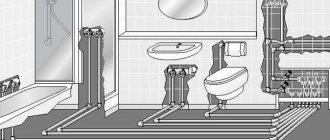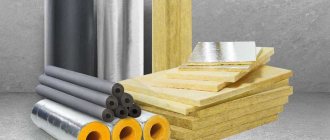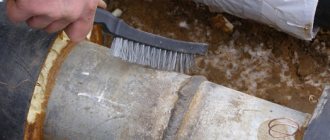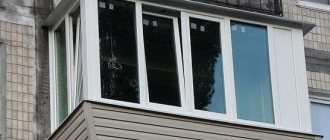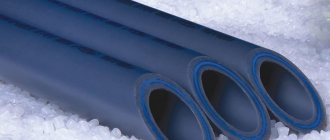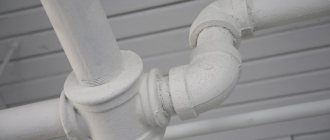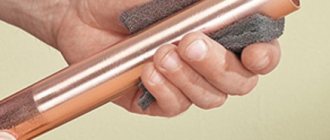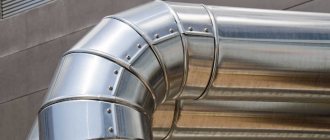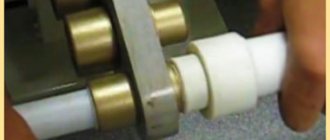What is basalt cardboard and where is it used?
Basalt cardboard is thin basalt fibers obtained by extrusion, bonded together with concrete clay.
Unlike mineral wool, which uses toxic phenol-formaldehyde components as a binder, the binder in basalt cardboard is environmentally friendly concrete clay.
Production technology
Basalt cardboard is produced by extrusion. An extruder is a special device with small holes through which basalt melt passes under pressure.
From the outside, cold air is supplied to the resulting fibers, which leads to the solidification of the basalt fibers.
The fibers thus obtained are compacted and cut to the required size. The average diameter of basalt fibers produced by extrusion is from 1 to 1.7 microns.
Scope of application of basalt cardboard
Due to its high heat and sound insulation properties, the material is widely used. Due to its high heat resistance, basalt cardboard is the best option for thermal insulation of heating boilers, fireplaces, stoves, stove dampers and other elements with high surface temperatures.
The material is indispensable for installing a heat-resistant layer between the stove and the flooring, as well as for insulating the chimney. Small thickness, high mechanical strength and fire safety have provided basalt cardboard with the widest range of applications.
In addition to insulating hot surfaces, it can be used for sound and fire insulation of concrete structures. The material is widely used for thermal insulation of loggias, balconies and terraces. Due to its low thickness, it is ideal for insulating air ducts and water pipes.
Insulation of a brick chimney
Insulating the chimney of a gas or solid fuel boiler made of brick is more difficult and will take more time
Slag-lime plaster
This type of chimney insulation is the least effective, although it is the easiest to do without any special skills.
- The first step will be to attach reinforced mesh to the outside of the brickwork.
- Preparation of the solution: mix washed slag, lime and cement (a little).
- The plaster is applied over the mesh in a four-centimeter layer.
- After drying, apply at least twice more, 5-6 cm each, it is important to let each layer dry thoroughly.
- Level the last layer (thicker). Cover all cracks and whitewash with lime.
Basalt with cladding
Basalt insulation for the chimney of a solid fuel boiler is used in complex insulation work with subsequent cladding.
- Cut mineral basalt slabs in accordance with the measurements of the surface to be finished.
- Attach them with tape (foil) or use staples. Wrap in foil.
- Make a brick cladding on top (followed by plastering) or build a metal frame and decorate the outside with siding.
Advantages of basalt
- environmentally friendly;
- unlimited service life;
- does not burn
- used at temperatures -300 - +900°C;
- does not emit harmful substances.
Thermal insulation with mineral wool plus plaster
- After thoroughly cleaning the brick surface, it is necessary to install a metal sheathing using dowels. It must be rigidly connected to the adjacent roof. The width between the profiles is equal to the width of the insulation sheets.
- Fill the sheathing with mineral wool, trying not to leave even the slightest gaps.
- Wrap the top with thermal insulation film (or foil) and secure with a stapler.
- Seal the joints with tape. Apply plaster on top. You can build a frame and veneer it.
If the smoke exhaust channel is external, it must be insulated along its entire length from the very beginning. If it is internal, then you need to start from the attic level.
All the options considered will be needed to repair an existing chimney; ideally, such work should be carried out during the construction stage of the house.
There are also now new technologies using ceramic pipes, or ready-made “sandwiches”, which already consist of two cylinders with a filler between them. However, the price for them is quite high, and it is much more profitable to do everything yourself. When choosing insulation, the last thing you need to focus on is price. In any case, the costs will not be high, since all work is done independently without the involvement of specialists. The material from which the smoke exhaust duct is made plays a decisive role.
Properties and characteristics
Basalt cardboard is widely used in modern construction due to its unique performance characteristics and affordable cost.
- standard sheet thickness is 6 mm;
- overall dimensions 1200x600 mm;
- operating temperature range from -200 to +7000C, in addition, the material can withstand more than 2000 cycles of amplitude temperature fluctuations;
- the specific gravity of the heat insulator is 600 kg/m3;
- the natural moisture content of the material is no more than 1%;
- the sheet can be compressed up to 20%, while it fully retains its technical characteristics;
- basalt cardboard is plastic and easy to cut. This allows you to isolate even complex surfaces;
- with proper operation, the service life is at least 50 years;
- the material is absolutely non-flammable and does not support combustion;
- basalt insulation is resistant to mechanical damage.
Advantages and disadvantages of basalt cardboard
The list of advantages is quite impressive:
- the material has high thermal insulation properties. Using it as insulation allows you to save significant amounts on energy costs;
- the soundproofing characteristics of basalt cardboard ensure comfortable living not only in a private house, but also in an apartment;
- hygroscopicity allows the use of cardboard in rooms with high humidity: saunas, baths, swimming pools, etc. In addition, mold and other types of fungus are unlikely to appear;
- high strength of the material ensures resistance to mechanical damage and a long period of operation;
- the relatively small mass of the sheet significantly simplifies the process of laying insulation. In addition, large sheet sizes speed up installation;
- facing with basalt cardboard significantly reduces the risk of fire, since the material not only does not burn, but also does not support combustion;
- insensitive to amplitude temperature changes. This allows the material to be used for both interior and exterior use;
- basalt cardboard finds its use in agricultural and food warehouses, since it is not at all interested in rodents.
A significant disadvantage of thermal insulation material is its high cost, but this is fully compensated by its long service life and high performance characteristics.
Insulation of a chimney pipe with basalt wool
The technology and mechanism for installing the casing is influenced by many factors, including the material from which the pipe is made, its diameter and others.
Basic rules for high-quality thermal insulation
Compliance with the following standards is mandatory when lining a chimney with a heat insulator:
- for a wooden covering, the layer of wool should be no less than 50mm and no more than 100mm;
- in passages through wood this layer should reach at least 5 cm;
- if mats of material are laid in several layers, then their joints must be covered with upper layers;
- for heat insulators in a cylindrical release form, when they are applied in several layers, each subsequent one must be laid with an offset of 180°;
- for boilers with liquid fuel or gas heating technology, it is advisable to use high-temperature cladding materials with a range of up to 300°;
- a protective screen is a mandatory insulation measure if materials without a foil layer were used during the work.
Insulation of a ceramic or asbestos chimney
For asbestos chimneys, the outer cladding procedure is carried out, and the layers of material are secured with special staples. To simplify and speed up the work, you can use basalt cylinders, the thickness of which should not exceed 5 cm.
Important! You will also need to additionally install an external steel casing (the best option is stainless steel or galvanized materials), and insulate the upper end of the chimney with a cement mortar.
Methods for insulating a steel chimney
The mechanism for carrying out the procedure is almost completely similar to the method for a ceramic chimney, and looks like this:
- 2 pipes of different diameters are used: a large one for the external surface, and a smaller one for interior decoration.
- One pipe is inserted into another.
- The resulting gap between the products is filled with the selected non-combustible insulation to insulate the chimney.
- If the material has a foil layer, it is not necessary to install a protective casing.
- The structure at the end must be additionally insulated.
The instructions themselves are quite simple, but they can be simplified by using ready-made sandwich pipes that replace the first 3 points of the manual. Such ready-made consumables for insulation have high heat resistance and help achieve high insulation characteristics.
Types of basalt cardboard
All existing basalt cardboard can be divided into three main modifications:
- ordinary;
- foil;
- needle-punched basalt mats.
Ordinary
This type of basalt cardboard is made exclusively from basalt fibers and concrete clay, designated as BVTM. The material is easy to cut and has a high degree of heat and sound insulation. The high ductility of the insulator allows the processing of complex spatial structures. Among other things, the material is highly vapor permeable.
Basalt foil cardboard
The main difference between foil cardboard and regular cardboard is that one side of the insulation is covered with metal foil. The foil reflects heat, which can significantly reduce heat loss, since the reflected heat is returned to the room. The foil can be attached to the base sheet in two ways: using metal wire or using resins.
If wire fastening is used, the material does not pose a danger to humans. If resins are used to attach the foil, strong heating may result in the release of formaldehyde, which can adversely affect the health of residents.
Needle-punched basalt mats
The main feature of needle-punched mats (BIM) is the method of fastening basalt fibers in the sheet. The fibers are fastened together with basalt needles, without the use of resins or cemented clay. This fastening method significantly complicates the installation process since the material turns out to be prickly and inconvenient to work with.
On the other hand, if you follow safety rules and use special clothing, it is quite possible to avoid unpleasant injections. This method of fastening does not affect the performance properties of the material in any way, and needle-punched basalt mats are much cheaper than conventional and foil analogues.
Take a closer look - basalt insulation for the chimney
The main forms of production of basalt insulation can be considered:
- Vatu;
- Mats;
- Rolls;
- Cylinders;
- Plates.
The secret of the effectiveness of basalt insulation lies in the ability to retain a sufficient volume of air in the body. It is the atmospheric layer that is the boundary element that prevents heat transfer, serves as a waterproofing agent and reliable insulation. The thermal insulation layer remains stable for quite a long time thanks to basalt fibers.
Basalt containing products are easily transformed. Their strength can be increased by stitching with metal wire or synthetic threads. Thus
Famous manufacturers
Currently, several well-known companies occupy leading positions in the field of basalt cardboard. The products of these enterprises have their own distinctive features.
Rocklight
The products of this company are distinguished by stable shape and volume of sheets, low moisture absorption, high sound insulation properties and minimal thermal conductivity. Standard sheet dimensions are 1200x600 mm. The material is easily cut using a hacksaw or cutter, which greatly simplifies the installation process. The cost of a 5.76 m2 package is 870 rubles.
Nazarovo
The materials produced by the company are widely used due to their hygroscopicity and fire resistance. The company's products are used for insulation and sound insulation of building structures for various purposes. Basalt cardboard is environmentally friendly, which is confirmed by relevant certificates. The cost of packing sheets measuring 1200x600 mm is approximately 960 rubles.
Rockwool
The company has long been known in the market as a manufacturer of high-quality basalt insulation materials. Rockwool basalt cardboard is weather-resistant, environmentally friendly, and has high heat and sound insulation. Standard sheet size is 610x1000 mm. A pack of sheets with a total area of 10.45 m2 will cost approximately 1,500 rubles.
Isoterm
The company produces basalt sheets of standard sizes 1200x600 mm. The company's products are characterized by low thermal conductivity, hygroscopicity and good sound insulation. Due to its plasticity, Izoterm basalt cardboard is often used for cladding various curved surfaces, chimneys, air ducts, etc. Cardboard is resistant to moisture and ultraviolet radiation. The average cost of a package is 1450 rubles.
Paroc
Due to their resistance to negative atmospheric influences and the ability to work at variable temperatures, the respans produced by Paroc can be used for both interior and exterior work. The flexibility of the material allows it to be used for insulation of air ducts, chimneys, heating boilers and other building structures. Paroc cardboard has low thermal conductivity and good sound insulation. The price of a sheet 600x1000x30 is on average 450 rubles.
BASWOOL
BASWOOL has focused on achieving the lowest thermal conductivity of basalt cardboard. That is why the company's products are widely used in industrial and civil construction. The hygroscopicity of the material allows it to be used in rooms with high humidity, and its high sound insulation properties increase overall comfort. Standard sheet size is 1200x600x100. The cost of 1 m2 is approximately 800 rubles.
Tizol
Another domestic manufacturer whose products are in high demand among private developers and construction companies. Soft basalt board BVTM-PM and basalt cardboard BVTM-K meet all the requirements of international quality standards and environmental safety. The insulation is available in both foil and simple versions. A high level of heat and sound insulation is provided by MPB mats made from ultra-thin staple fiber BSTV-st, with a thread diameter of no more than 3 microns. The mats are stitched with basalt fiber, which eliminates the use of binding components.
There are other manufacturers of basalt insulation, but their products are less in demand on the building materials market.
What affects the cost of basalt cardboard
The cost of the material depends on many factors. First of all, this is the presence of foil. Foil basalt cardboard will cost the buyer 20-25% more than usual.
The size of the sheets also affects the price of insulation. The greatest demand is for sheets of size 1200x600x10. A sheet of 1000x600x10 will cost a little less. There is also cardboard 6 mm thick. The cost of such material in a foil version ranges from 170 to 220 rubles, in a regular version from 150 to 190 rubles.
The next criterion that influences the price is the thickness of the basalt fiber used for the production of cardboard. There are two types of fibers: superfine and medium fibers.
Mats made from thin and superfine fibers are more expensive, but melt faster at temperatures of 7000C or more. If the material will operate at extreme temperatures, it is better to use medium-fiber cardboard.
As with the purchase of any other product, when purchasing in bulk, the price of basalt cardboard can be significantly reduced due to discounts, promotions, bonuses, etc. It should also be taken into account that products from well-known brands, even with the same quality, will cost more than products from little-known manufacturers.
Where is basalt cardboard used?
Basalt thermal insulating cardboard is used for insulating furnaces, boilers, dampers, doors, and chimneys. Basalt mats are indispensable for a heat-resistant layer between the floor and the stove, roof and chimney ─ where fire protection, density and thinness of the material are important.
In residential construction, basalt mats are used for simultaneous noise and fire insulation of concrete floors. Loggias, balconies, terraces and even entrance doors are sheathed with basalt cardboard. Cardboard is used to insulate air ducts in ventilation systems and water pipes.
How to attach basalt cardboard
There are several ways to attach basalt cardboard. The choice of one or another technique depends on the specific operating conditions. For interior work, gluing mats using liquid nails or assembly adhesive is quite sufficient. In addition, the sheets can be attached to the walls using a stapler or self-tapping screws.
If foil-coated basalt cardboard is used, the foil should face the inside of the room. The foil will reflect heat back into the room, which will increase the effectiveness of thermal insulation.
During outdoor work, the number of unfavorable factors increases noticeably. In order to ensure reliable fixation of the insulation on the facade of the building, special fasteners are used.
To conclude the article, we present several reviews from builders regarding basalt cardboard published on the Internet.
Why insulate
Regardless of the type of heating in a private house (boiler, fireplace, stove), the gases flowing from the boiler into the chimney have a fairly high temperature.
Since the temperature in the atmosphere is low, and the temperature of the gas is much higher, vapors are released (when one cubic meter is burned, about two and a half kg of vapors are released) and settle on the walls. And the fuel for a solid fuel boiler is peat, firewood, coal, and granules, which oxidize during combustion. In this case, the pipe does not have time to heat up enough so that the gases do not condense. This is especially true for modern boilers that have an automatic system, in which they do not operate constantly, turning off periodically, and the pipes have time to cool down completely. Although this also happens with stove heating, because the stove is not heated all the time. Combustion products dissolve in the resulting condensate, forming harmful acids (very aggressive carbon, sulfuric acid), which eventually destroy the structure. The consequences lead not only to heat loss, but also to the possibility of disruption of traction, sometimes even an explosion. Do-it-yourself thermal insulation of the chimney will help to avoid these problems and extend the service life of the structure, as well as reduce repair costs. You just need to choose the right insulation; there is enough information and videos on the Internet for this.
Chimneys made of any materials - metal, asbestos, brick - are susceptible to harmful effects, and the choice largely depends on them. The general recommendation is to avoid flammable materials due to the high heating temperature.
Non-combustible insulation options:
- rockwool;
- fiber;
- glass wool;
- slag concrete and others.
In order to insulate the smoke exhaust channel from a boiler in a private house with your own hands, you may need the following tool (not all of them, depending on the chosen option):
- metal scissors, a sharp knife for cutting heat insulation;
- Bulgarian;
- screwdriver;
- construction stapler;
- protective equipment – gloves, goggles, respirator;
- roulette;
- trowel for finishing plaster.
Materials:
- metal profile;
- galvanized metal (options: wooden panels, siding, drywall, plywood);
- mesh (preferably galvanized);
- steel staples;
- dowels;
- selected non-combustible type of insulation;
- tape with foil;
- cement.
This article provides recommendations for those who are planning to make their own long-burning potbelly stove. How to make a wood-burning potbelly stove from a gas cylinder with your own hands, read:
